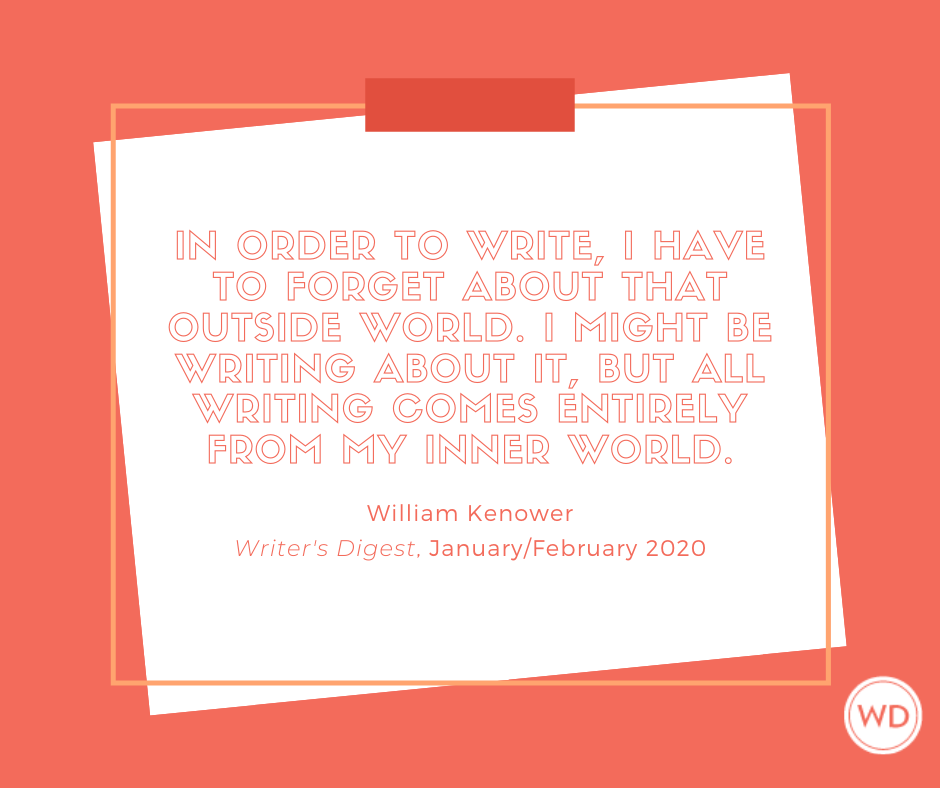Hold Them Back
Your fictional characters experience many emotions, but only one is absolutely essential to plot. Here’s how to fuel your story with frustration.
What's the most important emotion your fictional characters feel? Love? Hate? Anger? Desire? All of these are critical. Love for a person or desire to attain a goal drives countless plots, while hatred or anger drives most of the rest. Anna Karenina loves Vronsky; the wicked queen hates Snow White; Ahab is furious at Moby-Dick; Nero Wolfe wants to solve murders. And yet, the most important emotion in fiction is actually something else.
Frustration.
Without frustration, there's no plot. Period. Frustration means that someone's not getting what he wants, and that's what makes a story work. If Anna got Vronsky easily, or if Ahab harpooned that whale the first time he tried, both novels would be over. Instead, Anna and Ahab (plus the wicked queen and Nero) are frustrated in attaining their goals.
Let's look at this complex emotion's role in your novel, along with the best ways to convey it.
Characterization
Think about the people you know. Undoubtedly, your family and friends each handle frustration in different ways. Some typical reactions:
- anger
- tears
- determination to try harder
- blaming the closest person
- blaming the universe
- blaming oneself
- drinking
- venting to a trusted friend
- giving up
- seeking revenge on whatever's causing the frustration
- prayer
- affected stoicism
- depression.
Which of these responses to frustration will your character choose? The answer depends on two things: what kind of person she is and what you want your plot to do.
It's a good idea to think about these questions before you begin writing, because how a character reacts to frustration is tied to his characterization as a whole. For instance, a woman who reacts with no self-control whatsoever—throwing things and screaming—can't, in the next scene, be cool and calculating. Similarly, a man who blames himself for his troubles won't plausibly go and murder someone out of revenge.
So what kind of person is your character? From the first time she steps on stage, you'll want to know her natural responses to frustration, plus how good she is at controlling and modifying that response.
Here's Tom Wingo at the office of his sister Savannah's psychiatrist, in Pat Conroy's acclaimed The Prince of Tides. Tom's trying to see Savannah and is being frustrated by the doctor:
"Is the coffee good, Tom?" she asked with complete control.
"Yes, it's fabulous. Now, about Savannah."
"I want you to be patient, Tom. We'll get to the subject of Savannah in a moment," the doctor said in a patronizing voice shaped by far too many advanced degrees. "There are some background questions I need to ask if we're going to help Savannah. And I'm sure we want to help Savannah, don't we?"
"Not if you continue to talk to me in that unbearably supercilious tone, Doctor, as though I were some gaudy chimp you're trying to teach to type. And not until you tell me where my goddamn sister is."
In this tiny vignette, Tom vents his frustration through sarcasm ("Yes, it's fabulous"), impatience and anger. That's pretty much how he reacted as a child, and also how he'll react to other problems throughout the book, nearly destroying his family—until life teaches him to behave differently.
Plotting
How your character handles frustration will heavily influence your plot. Does she fight back, seeking revenge on whomever's blocking her? Then your plot will feature fights and payback schemes. Does he give up? Then someone will need to motivate and/or rescue him, or else he'll learn to live without whatever he wants (both respectable plots).
Consider, for example, Mario Puzo's bestselling novel The Godfather. When an attempt is made on Don Corleone's life, Corleone's two sons react very differently. Sonny wants to go roaring off for immediate revenge (he does this later, in response to a different frustration, and that reaction gets him killed). Michael, on the other hand, plans—coolly and rationally—to get even. His plans against everyone who's frustrated his family (a dirty cop, rival gangsters, Sonny's killer) provide the plot for the rest of this long novel.
So think again about how your character reacts when he doesn't get what he wants. Can his reaction provide you with plot ideas?
Dramatization
How well you portray frustration can make the difference between characters who seem real and those who seem cardboard. A common mistake is to assume that your readers just know what your character's feeling. This usually occurs because the author feels exactly what the character does and assumes the reader does, too. Say the protagonist hasn't been invited to her cousin's wedding. For the author, such a social slight would make her feel hurt and depressed, and she therefore has her character react exactly the same way—and she assumes the reader will automatically understand that. After all, wouldn't anyone feel that way?
Well, no. As we've seen, people react to frustration with an astonishingly wide spectrum of emotions and actions. (Some people, for instance, would be delighted to be spared a family wedding.) Therefore, you must dramatize this character's frustration, fully and convincingly enough for readers to share it.
Complicating this task is the fact that frustration isn't a "pure" emotion. It can come mixed with many others: anger ("How dare they!"), hurt ("Why won't they help me?"), fear ("I'm afraid I'll fail"), self-blame ("I'm not good enough to succeed"), resignation ("Can't win 'em all"), bitterness ("Life sucks") and more.
Not only do different people experience different mixes of these emotions when frustrated, but also the same person may experience different mixes at different times. Mood, health, that recent fight with the boss—all influence how one reacts to a given frustration.
How do you get all that into fiction? You don't, obviously, get it all in; fiction is a process of selection. But because frustration can evoke such different reactions in readers, and in the same character under different circumstances, it's important to fully dramatize this emotion. You do that through bodily reactions, carefully constructed dialogue and characters' thoughts.
Body language
An effective technique to dramatize your character's frustration (as with other emotions) is to show how it affects his body. We frequently react to emotion physically before we've had a chance to process information rationally. Anger, for instance, swoops through your body, affecting arousal levels, gestures, facial reactions, tone of voice, breathing. So use these to portray your character's feelings in a direct, visceral way.
In Maureen McHugh's wonderful science-fiction novel China Mountain Zhang, Alexei Dormov is visiting Martine Jansch (the story's narrator). Alexei's small daughter is playing with Martine's goats:
"Just my luck, my kid's best friend is a goat."
A world of regret in that comment, although he says it lightly enough. When his smile disappears and his face is still for a moment I assume he's thinking of Yorimitsu. I almost say, "Kids are resilient," even though it's one of those fallacies like middle-aged women liking children. But that's not what he's thinking at all. "Martine," he says, "they're going to transfer us again, and I don't know what to do."
"What?" I say.
"They're going to transfer me again. Isn't it enough to send us to Mars?" He never raises his voice, it is easy to miss the despair in what he says. ...
"What makes you think they're going to send you," I say, and realize as I say it that it sounds as if he's some sort of paranoid.
"I know. I've been through it four times. I know when they're going to ship us off." He balls his fists and puts them together as it all boils out of him.
Notice that, at first, even Martine doesn't know what Alexei feels. Then, the author uses Alexei's bodily reactions to help us understand Alexei's frustration. His face goes still. There's despair in his voice, despite its quiet tone. He balls his fists. Frustration "boils" out of him. And this is for a basically quiet, nonvolatile man. Alexei is no Sonny Corleone, but his body, as observed by Martine, dramatizes his emotion.
For a point-of-view (POV) character, you can use bodily reactions even more intimately. What do you feel when you're frustrated? Does your throat close up? Do your eyes tear? Do you get a sick feeling in your stomach? Notice your own visceral reactions and use them to create character frustration that your readers can identify with.
Dialogue
Bodily reactions, however, aren't enough. For one thing, the body uses the same reactions for different emotions: Tears might indicate frustration, sadness or even joy. Balling up your fists may simply represent free-floating rage against the world. Second,as we said before, different personality types react differently. What do those tears mean for this particular character in this particular situation?
For non-POV characters, supplement those bodily reactions with dialogue to make their frustration clear. But do be careful; avoid "As you know, Bob" dialogue, in which two characters tell each other things they both already know so the reader can "overhear" them. ("As you know, Bob, our mother died last year, and we two brothers became poor.")
Instead, set up a situation in which a character would reasonably talk out his frustrations with a listener who might reasonably sit still to hear them. The listener might be a friend, a spouse, a therapist, even a dog. The choice of listener depends on your character's personality and circumstances. It also depends on where you want the plot to go—and that's because the listener will have her own responses to the frustration she's hearing about. If her reaction is dramatic, it will affect the story. In the previous example, Martine responds to Alexei's plight by proposing marriage. As her husband, he becomes a landowner and doesn't have to be transferred.
Thoughts
For a POV character, you have an additional resource to dramatize frustration: the character's mind. Her thoughts allow the reader to share that emotion directly.
Look again at the brief excerpt from The Prince of Tides. Tom's thoughts about the doctor—she has "a patronizing voice shaped by far too many advanced degrees"—say a lot about his frustration with her, with his crazy sister, with the entire situation. Throughout the novel, the author lets us see directly into Tom's thought process, adding depth to his bodily reactions and dialogue.
Two caveats here. First, if your character is a logical person with a rational response to frustration, don't make her too logical. A character who calmly thinks, "Well, plan A failed, so let's move on to plan B," is simply not convincing. There needs to be some accompanying emotion and at least a brief period of confusion ("Plan A failed; now what the hell do I do?").
Second, don't substitute characters' thoughts for action. A frustrated character may think obsessively about his problem. Or he may plot out every detailed step to overcome what's frustrating him. Or he may wallow in despair. Whatever he does, show it. Some thoughts are good for clarity and flavor, but action and drama should carry the day—whether that reaction is throwing a fit (Tom Wingo), throwing more harpoons (Ahab) or throwing herself under a train (Anna Karen ina).
Frustration is universal. Make it work for you by building characterization, driving plot and hooking our sympathy on your characters' plights. What frustrates them will benefit your fiction.
Nancy Kress' latest book is Probability Moon, a novel told in multiple, middle-distance third person, for maximum flexibility.









